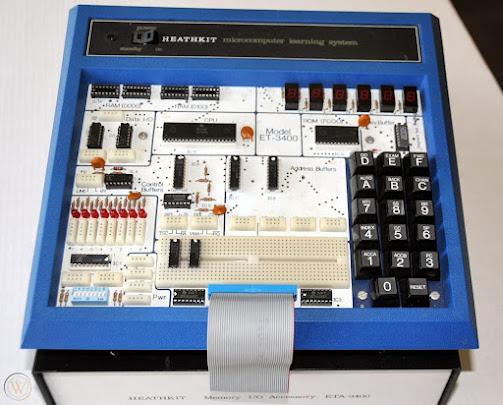First, a bit of background information on the ET-3400 Microprocessor Trainer and the ETA-3400 Memory I/O Expansion Accessory.
Back in 1976, Heathkit built a microprocessor trainer based on a 6800 microprocessor which had 256 bytes of RAM, a 1K monitor ROM, a hexadecimal keypad and a 6-digit 7-segment display. In most respects it would be considered to be a Single Board Computer (SBC). However one unique feature that differentiated it from other SBCs was it's built in breadboard section where you could build experimental circuits and interface those into the trainers address, data and I/O bus. The unit also came in a very nice blue plastic case with an inbuilt power supply.
This was a great trainer to learn 6800 microprocessor programming and how to interface circuits with a microprocessor, provided your circuit was relatively small and you didn't mind typing a lot of hex machine code from the keypad. Once your programs grew to more than a few dozen bytes, the task became tedious. Even a 256 byte program is not something you want to type in every time you turned the machine on, keeping in mind that there was no secondary storage built in, and no simple way to transfer files across to it.
The original unit was up-gradable from 256 bytes to 512 bytes of RAM if you added an extra two 2112A static RAM chips. At the time RAM was very expensive and many computers were manufactured with small amounts of RAM and typically had expansion sockets for more RAM if you could afford it.
Later on the ET-3400 model was updated slightly and was given a new model number of ET-3400A. The new model had a 6802 CPU running off a crystal based 1MHz clock, where the original ran on a 2-phase RC based clock oscillator IC running at about 500 KHz. The monitor ROM was replaced with a 2716 pin compatible AM9716 which contained the same 1K monitior ROM. The RAM on board was reduced to two larger RAM chips instead of four, however they still only provide the same 512 bytes that the original ET-3400 could be expanded to, wasting half of the potential 1K RAM. I believe this was done for backward compatibility. Many web sites misreport the ROM as 2K and the RAM as 1K, however this is based on the size of the IC's rather than the actual amount of memory mapped into the trainer.
In 1978, Heathkit built a Memory I/O Expansion Accessory for the ET-3400 with a very similar and somewhat confusing part number of ETA-3400. Even to this day I see people misusing all these similar part numbers as I probably did myself early on.
The ETA-3400 was plugged in to the ET-3400 via a 40 way ribbon cable and expanded the trainer to 4K ROM, 1K RAM (expandable to 4K), and a 6820 PIA providing a serial cassette port and a bit-banged serial terminal port. The ROMs contained a much improved 2K serial monitor which also had different names (Heath/WINTEK monitor and Heath/Fantom II monitor), and a 2K Heath/Pittman Tiny BASIC. I will refer to these as Fantom II monitor and Tiny BASIC for this project. The unit had it's own inbuilt power supply to handle the extra load of the circuit, rather than piggyback off the already strained ET-3400 PSU even though the +5V, +12V and -12V lines were connected through the ribbon cable on the expansion port.
Before you could use the ETA-3400 with your ET-3400 or ET-3400A there was a modification required to the trainer. For the ET-3400 this also meant upgrading the RC clock to a crystal based clock so it brought it up to the same 1MHz speed as the ET-3400A. Heathkit recommended that before the upgrade was performed that users should complete all the test programs and experiments in the manuals first as they were written to run on the slower ET-3400 unmodified unit.
In my experience you could modify some of those programs to run at the faster 1MHz speed instead, but this comes down to years of experience that I've gained, and not something that a new user in 1978 would readily understand.
The ETA-3400 brought the trainer up to the status of a 'computer' in it's day, somewhat comparable to an MITS ALTAIR 8800 or IMSAI 8080 built a few years earlier and at a much lower price tag. You still needed to connect a serial terminal in order to use it, but you have secondary storage via cassette, a serial terminal monitor for entering and debugging code and Tiny BASIC.
While the ET-3400 or ET-3400A are still relatively plentiful on eBay or other sources and somewhat affordable, the ETA-3400 is much rarer and therefore more difficult to obtain. Personally I own one ET-3400 and one ET-3400A which I purchased as a budle from the US for around $140AU about 20 years ago. I don't have the ETA-3400 and I wasn't even aware of it's existence until many years later. I was first exposed to the ET-3400 trainer when I was completing a Radio Technician course back in 1991, but at the time I had other computer interests and a limited budget.
That's a brief overview of the Heathkit ET-3400 trainer and the Heathkit ETA-3400 Memory I/O Accessory. The main aim of part 1 of this project is to build a modern version of the ETA-3400 with more RAM. Next I'll discuss the memory mapping plans.







No comments:
Post a Comment